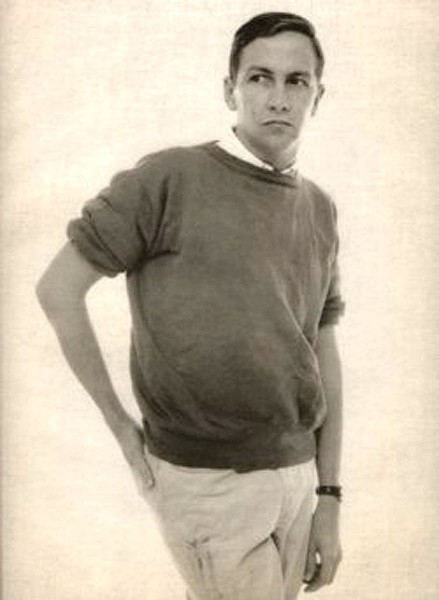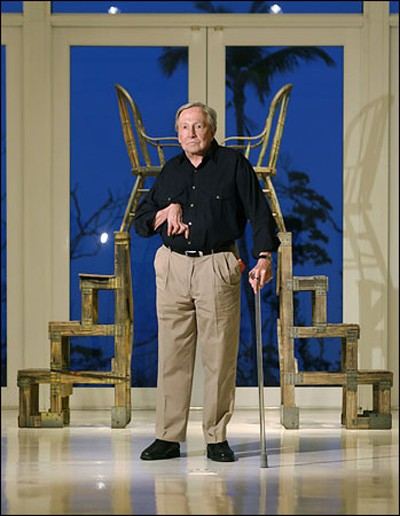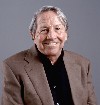Rembering the Artist Robert Rauschenberg, 1925-2008
Considering the Pop Pantheon
By: Charles Giuliano - May 13, 2008
During the time when the authority of Abstract Expressionism was waning as the most advanced movement of post war American art there was much discussion among artists about a "return to the figure." A style of "figurative expressionism" was evolving from the "Woman" series by de Kooning and the reemergence of figurative elements in the late work of Pollock. The new style of figuration was already forming in the Bay Area artists like David Park, Richard Diebenkorn, and Joan Brown, in the then Chicago based, Leon Golub, the transitional Larry Rivers, or the East Coast artists, Bob Thompson, Lester Johnson, and Jan Muller to mention just a few of the most prominent artists a number of whom were included in the seminal, 1959, Peter Selz curated, MoMA exhibition "New Images of Man."
But this emergence of "Figurative Expressionism" was preempted and relegated to an art historical footnote with the development of the "New Realism" which came to be more widely known as "Pop Art." Like most generic designations it does not aptly fit or describe the work of all of its best known practitioners.
Like mythical Greek gods the leading Pop artists seemed to leap full grown into the zeitgeist of the American art world fueled by a feeding frenzy of media and paparazzis. It didn't hurt that several of the leading artists emerged from backgrounds in commercial art which they both emulated and influenced. Compared to the complex angst and diffidence of the long suffering Abstract Expressionists the Pop artists seemed to thrive in the spotlight of media attention and social acceptance. They were glib and clever in marketing themselves as stars and media darlings as well as promoting work that was just deadpan and accessible enough to grasp the imagination of the masses. Andy Warhol was the rare example of an artist whose celebrity expanded beyond the confines of the art world.
By embracing the cartoon as art, and using the techniques of Mechanical Reproduction that philosopher Walter Benjamin had discussed as early as the 1940s, Roy Lichtenstein became as rich as Warhol was famous.
Initially, Pop was dismissed as crass and vulgar by leading critics such as Clement Greenberg. There were articles at the time about High Brow, Mid Brow, and Kitsch. This was also a period when satirists were advising us to get over all the agita and learn to Love the Bomb. Tom Wolfe, an advocate of the New Journalism, in 1968 wrote about the "Electric Kool-Aid Acid Test." Our generation took to the streets inspired by the Stones anthem "Street Fightin Man" or "Revolution" by the Beatles. We dropped a tab of Sunshine and sat in the mud of Woodstock for three days of peace, love and happiness. We "got high with a little help from our friends."
In the visual arts Pop declared that is was ok to have fun. That irony and humor were every bit as legitimate as the inner turmoil and anguished surfaces of abstract expressionism. With tongue in chic Rauschenberg used the "drip" of de Kooning and Pollock as a "decorative" and "gestural" element in his paintings and wildly inventive combines. Lichtenstein made flat, silk screened parodies of those signature slashing brushstrokes and drips. We joined him in laughing all the way to the bank.
In an echo of Benjamin artists learned that they didn't have to invent anything new under the sun when there was an unfathomable data resource of images ready for appropriation. The Pop artists lifted and appropriated with reckless often gay abandon. Until they got sued. Congressman, Sonny Bono, (formerly the clown of Sonny and Cher and the butt of all those "short" jokes) managed to slip through an extension of copyright law that makes a mockery of the notion of eminent domain. Disney and RCA will own forever in our lifetime the rights to Mickey Mouse and Elvis. While in the art schools kids appropriate until the cows come home. Or they are big enough to get sued. It is part of the cost of fame for contemporary artists.
Today, we note the passing of yet another of the major Pop masters, Robert Rauschenberg. Is there now enough time and distance to begin to sort out the relative importance and ranking of the founding Pop artists? In the inner circle of critics and academics Jasper Johns has long held the most prominent position. His oeuvre is small and concise. He appears to agonize about the work. The pronouncements he occasional reveals to persistent and patient interviewers (like Calvin Tomkins in the New Yorker) tend to sound like the utterances of the Delphic Oracle. Their opacity and obscurity only enhances his reputation as a seer. By contrast, the quips of Warhol were more amusing, diverting and accessible.An enduring example is his observation that "In the future everyone will be famous for fifteen minutes." He was, to interviewers and fans, whatever they wanted him to be. It was his genius and brilliance. As we noted yet again while touring the Warhol Museum in Pittsburgh the work of Warhol is always less and more than meets the eye.
If Johns is widely viewed, by those who know, as the greatest of the Pop masters then where to place Rauschenberg? I would suggest on an equal footing, if not better, on any given day, or example of the work. There is also an enormous part of the oeuvre which is at best fast, easy and experimental. When visiting the sprawling retrospective mounted by the Guggenheim in two locations, uptown as well as the now shuttered Soho branch, there was the pressing need of visitors to edit the experience. It was hard to digest just what aspects of the work, beyond a handful of well vetted masterpieces, were truly of lasting impact and quality.
What one most admired about Rauschenberg was the endless energy and willingness to take risks. And, if you have seen any of the videos of him at work, one senses the infectious fun and spontaneity. He appeared only to be emotionally involved in the process and creation of work which experimented with many media and styles. There was a Teflon aspect to his creativity as flops and negativity never seemed to stick to his persona. Of course, this is only speculation, as I am sure a more careful study or biography will reveal the doubt and anxiety that is central to the creative process.
Much has happened in the art world since those free wheeling days of the 1960s. What seemed so fresh, outrageous, and casual is now sifted through and analyzed by the humorless and intense new generation of students and scholars. They extol dense theories about everything. There are ubiquitous Warhol seminars. Always very popular with undergraduates, although the professors insist on "serious" work. Which seems so alien to the spirit, and intentionality, of the artists and the irreverent era that they signified.
The prior generation of Abstract Expressionists suffered to sing the blues. The Pop artists partied until they dropped. Now they are dropping. But I will forever love, honor and respect everything about Robert Rauschenberg. He tried so many things. Consider the collaborations with John Cage and Merce Cunningham. The inventive graphic works. Happenings. The paintings, silk screens, and then later the Iris rubbings, wacky sculptures and combines. The infectious laughter while discussing the work. Rauschenberg always makes me feel better about myself. What more can one hope for from an artist?



